Sign up for daily news updates from CleanTechnica on email. Or follow us on Google News!
Under the auspices of the India Smart Grid Forum, the think tank founded as an umbrella organization over India’s 28 state utilities to provide thought leadership, share leading practices, and bring international insights to India, I’m delivering bi-weekly webinars framed by the Short List of Climate Actions That Will Work. With the glories of online recordings and AI transcription tools, it’s relatively easy to share both the transcript and the slides that I used, so I’m making a habit of it.
Reji Pillai (RP): Good morning, good afternoon, good evening, welcome you all to the 7th edition of this webinar series today. Unfortunately, I’m in an airport, so I will keep my video shut and my speech also very short. As most of you know, more than 120 countries have declared their net zero target, varying from 2045 to 2070. But very few of them have a roadmap for shutting down their fossil fuel power generation plants. So that is one of the major milestones for achieving net zero. However, people are not India. We have a net zero target of 2070. So we have been arguing that in order to achieve net zero by 2070, the power sector should be net zero by 2050. So there are many new power plants, I mean old power plants which need to be shut down. There was different dialogues happening at different levels.
But in the last two 5-year plans, we didn’t plan many of the coal plants. And the last authentic report, which I know about, is about 8000 megawatts of new coal plants will be built in states like Gujarat, Rajasthan, etcetera, to stabilize renewable generation, which they are currently facing major issues. So this was the scenario till two months ago. In the last month, there are so many coordinates. We hear about a new target. Somebody talks about 28,000 megawatts of new coal generation. Somebody talks about 80,000 megawatts of coal generation. So 80, when it came, I thought it was a spelling error. I mean, say, error. 8000 is misspelled as 80,000. But this renewed vigor in new coal plants India is something really worrying. And we don’t know what is authentic and official, but there’s no word from the ministries or anywhere.
But there is a lot of talk going on. And the same is the case with many other countries. On one side, we’ve been talking about net zero and moving completely to renewables and green energy. And on the other side, coal is having a new lease of life. So Michael has done extensive research on this area and he will be presenting to you how it is economically, environmentally beneficial to move to renewables and storage. Over to you, Michael.
Michael Barnard (MB): Thank you Reji, and thank you to the ISGF, as always, for having me. I’m privileged to be able to share my perspective, to assist India to thread the needle between increasing affluence and bringing the remainder of your citizens out of poverty and also achieving climate goals, both of which are essential. And it is possible for this topic. I’ll say this very clearly. I’m from a country with among the highest emissions per capita in the world and they’re not going down. Particularly when I talk to people in developing nations, I’m not saying shut off all coal, don’t build coal. That’s not the story. It’s much more nuanced than that. And so let’s step through it and then we’ll have a good discussion at the end.
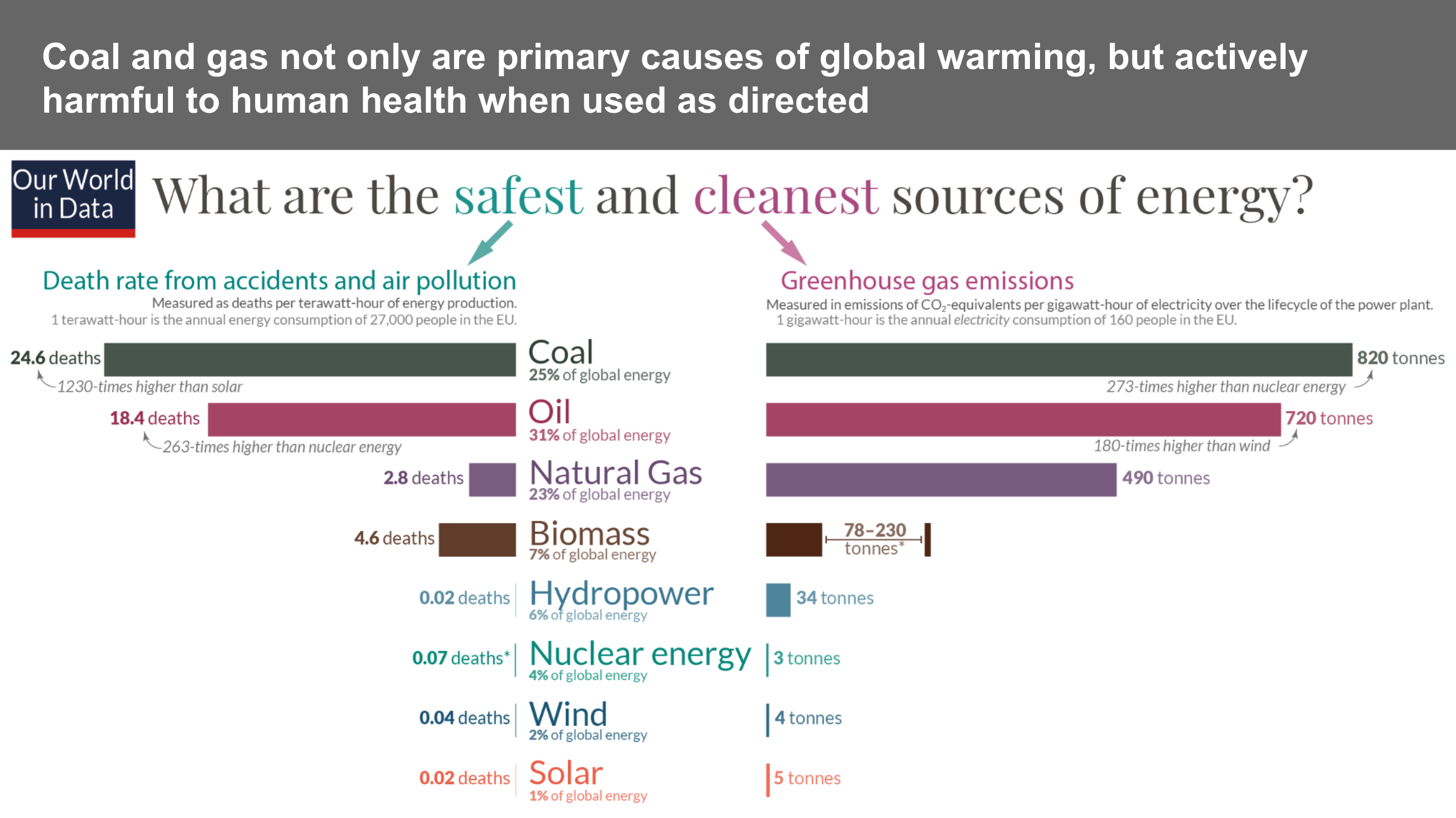
First off, there’s a really interesting point, which is coal kills, gas kills, and oil generation kills, they basically are really problematic. They are also very high emissions. While they have benefits of providing electricity, which powers hospitals and powers industry and stuff like that, they come with very significant downsides on both sides of the ledger and direct and indirect impact. I did the math a few years ago, and the United States coal fleet, for example, killed an average of 80 people a year for each coal plant. It was just a horrific death toll for what it was.
And I certainly remember looking at Duke Energy in the southeastern United States, where they were complaining about having put on more solar, but they were burning a lot of natural gas. The natural gas add was creating smog, which is creating childhood asthma and impacting people with vulnerable cardiovascular systems.
Obviously, we start seeing down here that the technologies of the future are much more virtuous, both in terms of population health and in terms of climate change. So regardless of anything else, shifting radically to achieve decarbonized energy has multiple benefits.
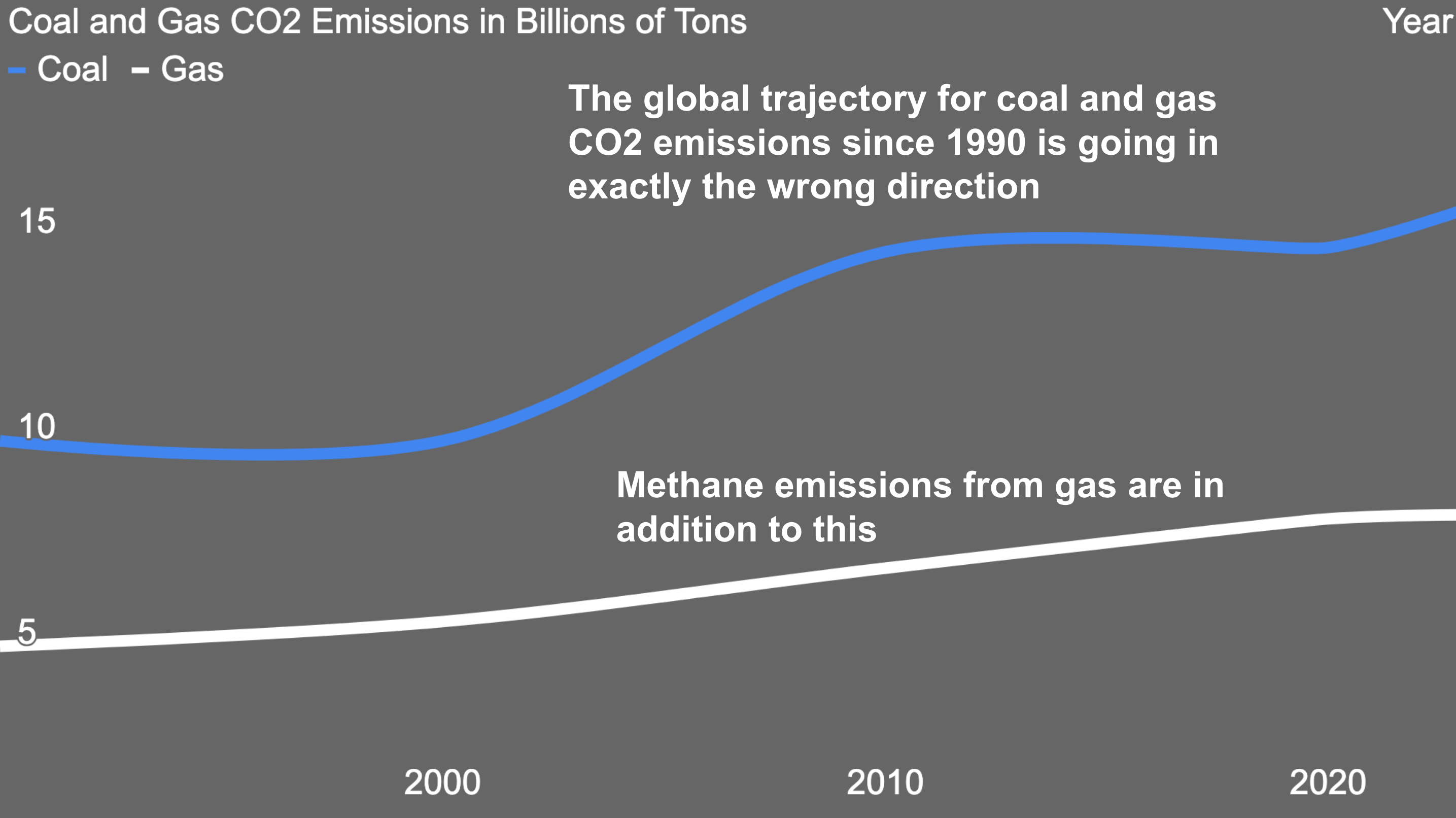
Let’s step through some examples of what’s been happening now. These trajectories are for CO2 emissions from coal since 1990 and CO2 emissions from gas generation since 1990. Clearly, since 1990 is the baseline for wanting to decarbonize. Clearly, we’re not doing a very good job of that. But I would like to point out that the global GDP and decrease in poverty since 1990 in major countries like India and China and Brazil has been extraordinary.
So the growth in emissions has not been as bad as it could be, I guess, is the way to describe it. And there is a lot of hope on the target. I will say that this blip upwards in the past few years is worrisome, but I suspect that’s going to turn down, and I’ll share why.
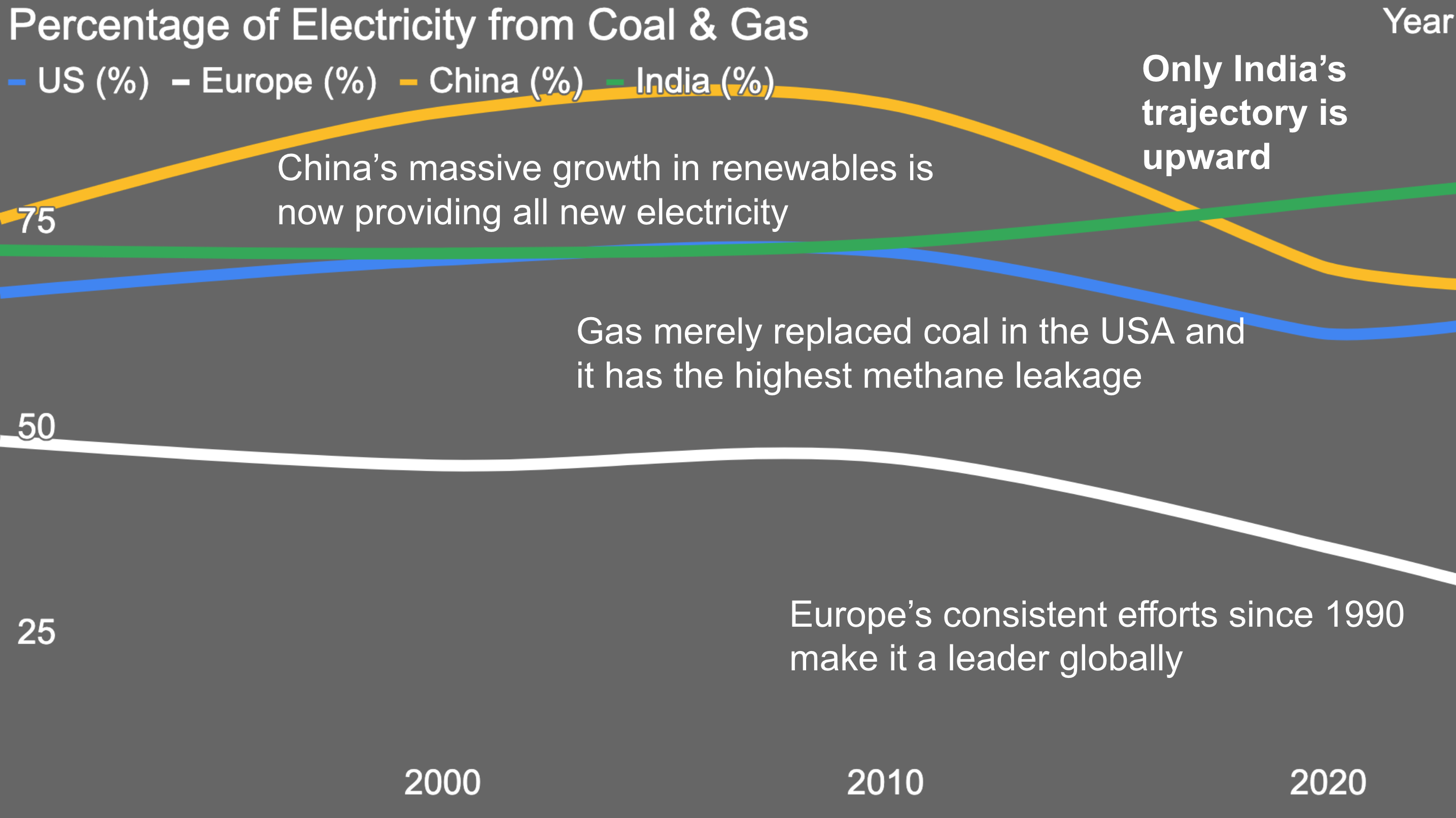
Now, as we look at that, there’s a different way to cut this data. And by the way, I apologize, in the sense that this is data I assembled over the past couple of days for this presentation. And so maybe it’s imperfect from public sources. Don’t quote it as specific. That’s why there’s no lines on the charts. That’s why there’s no numbers on some of these charts. They are accurate enough for this discussion.
But as we look at this, what we see is percentage of electricity from coal and gas for major economies of the United States, Europe, China and India. What we can see is that Europe since 1990 has actually quite significantly dropped the percentage of electricity that it generates with natural gas and coal. So that is actually very positive. They’re a world leader on many fronts, and they are virtuously trying and they’re virtuously succeeding. So if you have to emulate somebody, look to Europe. Now, the United States likes to make the claim that it’s reduced its CO2 emissions quite substantially and claims virtue by shutting down coal. But really, you’ll see that this is a fairly flat line. They’re still generating an awful lot of electricity. They’ve just replaced coal with natural gas.
And to be clear, that solves some of the health problems, but it doesn’t solve the climate problem, because the United States methane emissions leakage from their oil and gas industry is the highest in the world. Their regulations upon the industry were lax and their engineering was lax, and as a result, it leaks like a sieve. And the carbon dioxide equivalent emissions from methane have completely replaced the reduction in carbon dioxide from coal. It’s not a great story. So replacing coal with natural gas is not a slam dunk.
As India considers its coal in the future and is considering LNG imports, which are much more expensive, be really careful, especially as we’ve seen that LNG engines have significant methane slippage, vastly higher than models had expected. After we’ve done the studies, LNG imports are actually quite high carbon dioxide or equivalent emissions.
So China, on the other hand, had a fairly high percentage of electricity generated from coal. But now, as it’s hammering in renewables, you’ll see its curve is very positive. We’re actually seeing now the benefits of China’s massive renewables proliferation. They’re now approaching seven gigawatts of capacity a week between wind and solar. It’s a quite extraordinary pace of deployment, and that is definitely something that India should be emulating. If you want to emulate something out of China, hammer in a lot more renewables.
Now, India is an interesting one. It’s been fairly stable, but it’s been trending upward. So despite the focus on renewables, in the past decade, India has been building more coal while it’s increasing the consumption of electricity in the country. That’s a worrisome trend because wind and solar are now so cheap. I was somewhat surprised by that.
To Reji’s point, that seems to be something that India is leaning on even more heavily, even as the rest of the world is declining in terms of its coal use. The health impacts of coal can’t be understated. That has significant implications on productivity of your workforce. It has significant implications on the cost of healthcare in the country. And it has, of course, the challenge of so many people dying and then leaving bereaved relatives and loved ones. Gas is better than that, but it’s not that much better. But there are some solutions.
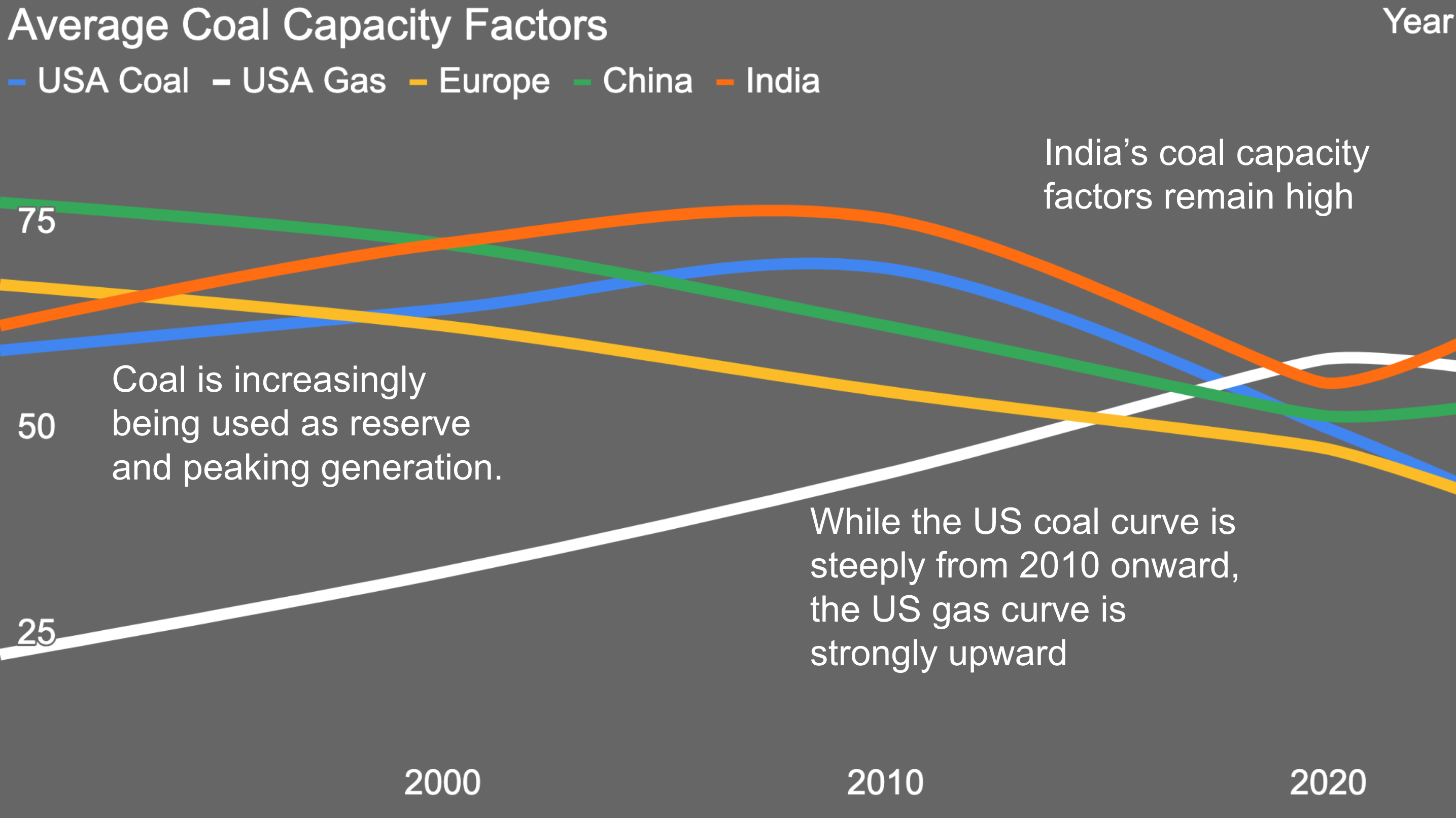
Now, here’s a way to think about coal. So these are average coal capacity factors. The percentage of the year, as you’ll see over here, historically, were quite high. Coal plants would run 75% of the hours of the year, or 70% of the hours of the year. And that would be kind of in that baseload model, and be turned off only as necessary, only for maintenance, only when demand was appropriate.
But what we see is that in this period, we’re seeing significantly declining capacity factors for coal plants. What that means is that coal plants are now being used as flexible generation to enable and balance renewables. If you look at China, they’re now down at 50% or so capacity factors on their coal plants, and they’re running them as the generation of last resort. If there’s wind, solar, or nuclear or hydro available, they use that. And then only if they need coal do they turn it on. And so they’re engineering for that. That’s the appropriate choice. I expect to see this line in the next few years decline quite substantially.
We’ll talk a bit about the implications of that as we move forward. As we look at some other countries like the United States, you see quite a substantial growth in coal generation through 2010. And then they have their much lauded decline of coal. So we see approaching 75% capacity factors in 2009 or so, but now they’re down at 40%. That’s the right trajectory. And to be clear, they’ve also shut down a lot of coal plants. So that’s a positive statement for the health of people in the United States.
As I said, they replaced it with natural gas. And as you see, this is the only natural gas line on the chart. They went from 20% capacity factors for natural gas, used only as peaking reserve and day ahead reserve. Now they’re up at very high capacity factors for natural gas, over 50%, 58%, because they’re using it the way they used to use coal. They built massive amounts of natural gas and they’re using it a lot, and they’re leaking a lot of methane. So if anybody from the United States tells you they’re virtuous because of natural gas or shutting down coal, the story is much more nuanced there.
As we get into Europe, they have a lot less capacity in the form of natural gas than the United States did. They build a lot less of it. Since 1990, they’ve been reducing the capacity factors of their coal plants to among the lowest on the planet. And they’ve also been shutting down coal plants. So once again, positive statements, positive ongoing efforts from Europe, and they’re not replacing coal with natural gas to the extent the United States did.
As we look at India, what we see is India’s industrial sector was fairly limited in 1990 by comparison to China or the west. Still significant industry in Gujarat and other places. But over time, through the 2000s, what we saw is very significant increases in electricity demand, per the data I have, as India’s economic boom was starting. But even there, even India, what you’re seeing is a very significant decline in capacity factors.
A little bit of an uptick in the past year, but still what we’re seeing is below historical levels, it’s below the peak levels. That’s the right trajectory and expect that to continue. Everybody knows that you don’t want to burn coal if you don’t have to. India is going to have to burn a lot of coal over the next 20 or 30 years, but it’s not nearly as much as historically, because it’s not baseload anymore. This chart is strongly indicative that the paradigm of base load generation from coal or any other technology is really playing out globally exactly the same way. Everybody is treating fossil fuel generation as generation of last resort and using it as declining capacity factors.
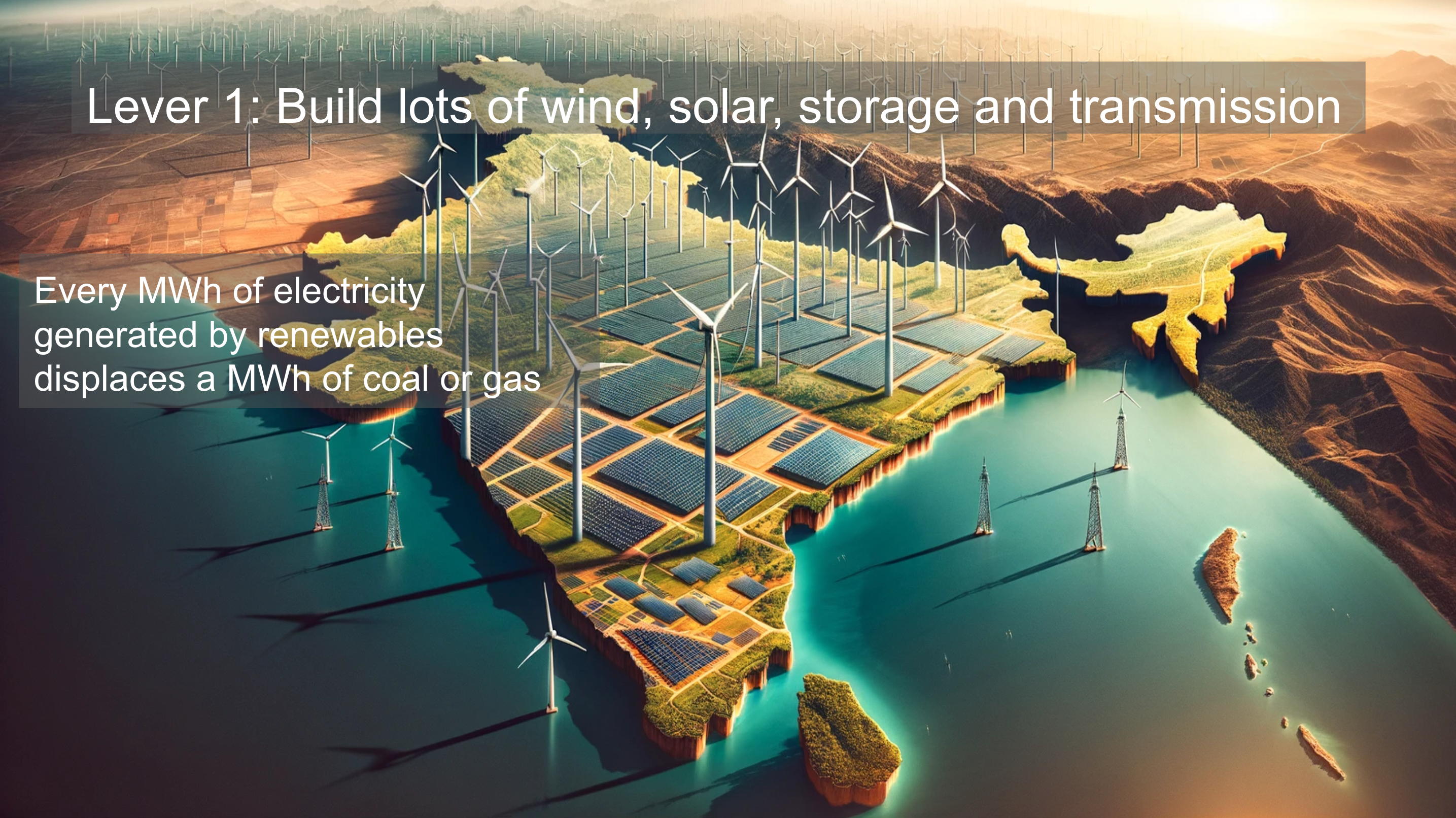
So there some levers to pull as you move forward. The first one, of course, is to build lots of wind, solar, storage, and transmission. This is not rocket science. I won’t dwell on it too much. But every study that’s been done says every megawatt hour of electricity that we get out of wind, solar, and water eliminates a megawatt hour of electricity from coal, gas or oil. Those are very virtuous statements. It doesn’t really matter about anything else as long as you’re hammering it as much as possible. Clearly, India needs to do what everybody else except China needs to do, which is accelerate its deployment of renewables. Everybody on the planet is lagging in terms of deployment of renewables, except China, because it figured it out, and it figured it out 10 or 15 years ago. Created the national strategic goal to be a global leader in those technologies, and that’s paying domestic and international dividends now.
But I’m not saying that Europe is building enough, I’m not saying North America is building enough. I’m just saying India needs to significantly increase its build-out of these things in order to achieve true zero emissions and to continue lowering the capacity factor of coal plants.
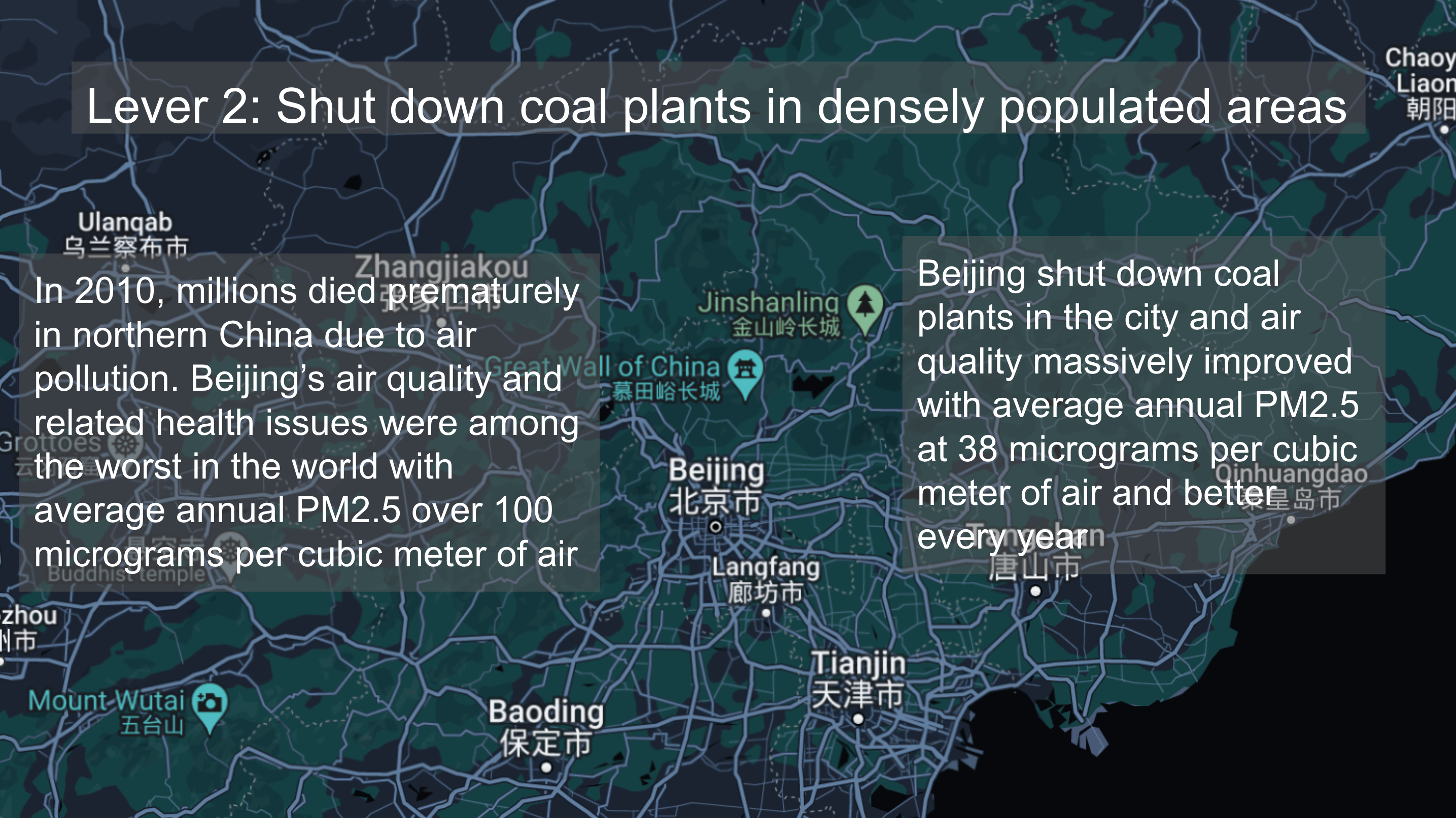
The next lever that I’d like to talk about is shutting down the coal plants where there are lots of people. As the 2010 Olympics were emerging in Beijing, there was just a lot of press globally about the air quality in Beijing. It was among the worst in the world. The US embassy, for a while, very cheekily, was actually publishing the PMQ counts from their air monitors on top of their embassy. That was actually turned into a bit of a minor diplomatic incident.
The government was looking at this and going, this is a black eye. And further, China is not a democracy, as India is, but all governments rule at the will of their people. The way that they put a gloss on it in China is that various empires lost the mandate of heaven. And what that really means is they ruled so badly that the populace said, you have to go. And eventually they went. And that’s happened five or six times over the history of China, at various times. Air quality in China was one of those mandate of heaven things. As was more recently the lockdown, late in the COVID cycle, they were losing the mandate of heaven, the will of the people.
In the 2000s, they were putting schools inside tennis domes with filtered air. In 2014, my company wanted me to move to Beijing and I said, my wife and I like walking outside and we can’t in Beijing because it the air was so bad. What they did is they said, one of the many things they did was they said, well, all the coal plants in and immediately around Beijing are going to shut down. That meant that all the massive health impacts of those coal plants diminished substantially. Now they’re in parallel building other stuff elsewhere. But also the thing about coal plants in developed areas, frequently, they’re the oldest coal plants, they’re the worst, they’re the dirtiest.
As they shut down those coal plants and replaced them, in many cases, the supercritical coal plants, they significantly decreased the CO2 emissions from coal and significantly reduced the health impacts of coal. So a very good idea is assessing where your coal plants are and assessing where you plan to put them to avoid that.
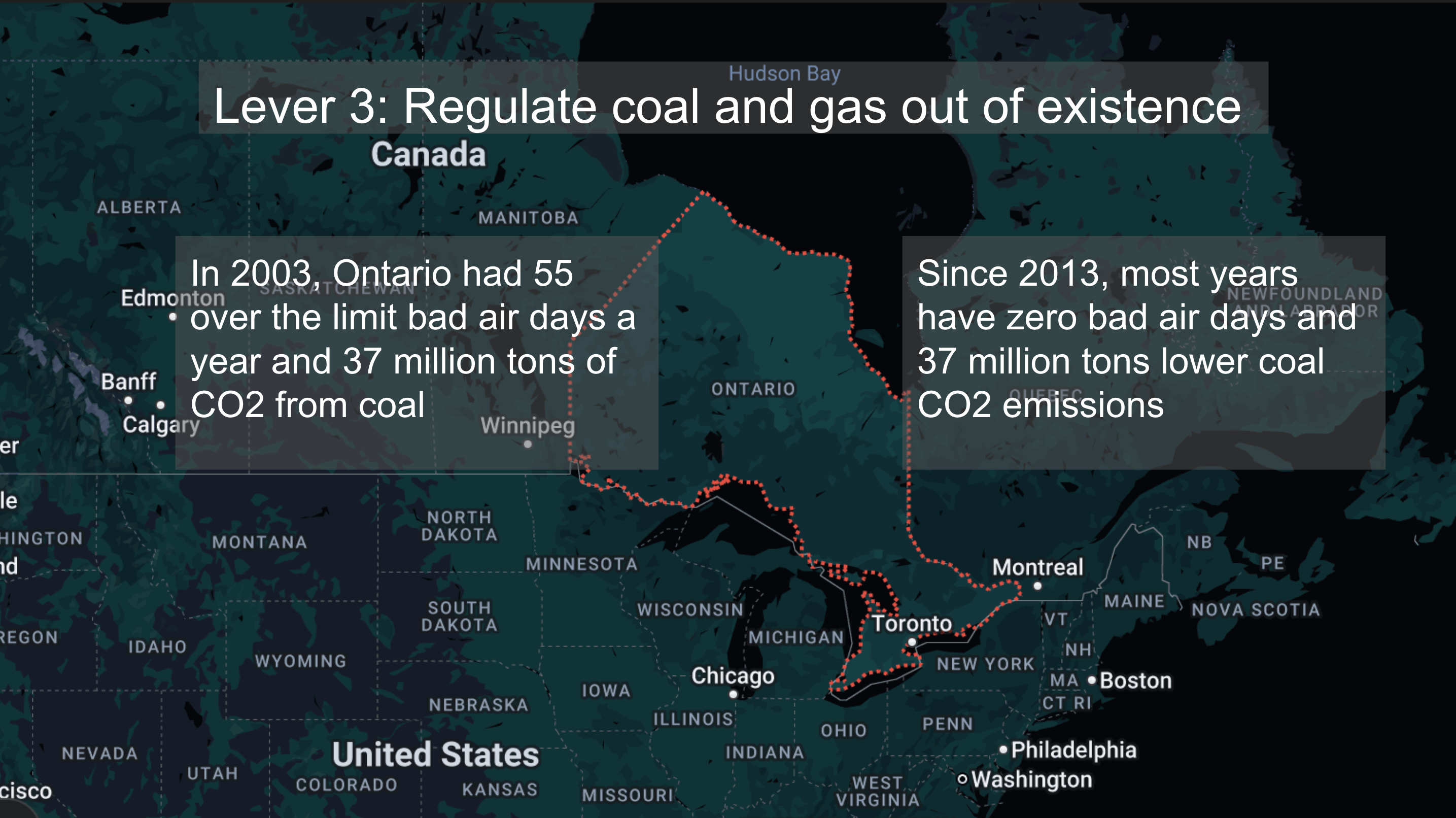
Now there’s another lever, and I’m just going to talk about Ontario. Ontario’s one of the places I consider home. I lived there for approaching half my life in multiple stints. I’m going to be there next week. Ravi, who’s on the call, is in Toronto right now. I consider it my home. I’ve lived in many parts of it. But one of the reasons I left in 1999 is because the air in Toronto was so bad.
The air in Toronto was so bad because we used a lot of coal generation and we had car emissions, but the coal generation was the real problem. So the government at the time, the Liberals under McGuinty, said, you know what? For climate reasons and public health reasons, we commit to shutting down coal. And they said, we’re going to do it in ten or eleven years. They committed to do it by 2013, I believe. And they regulated that. They said, this is what you’re going to do. Ontario generation organizations figure out how to replace that. Now, Ontario has a significant nuclear fleet. It’s the only province in Canada that has a significant nuclear fleet. Approximately 45% to 55% of its electricity comes from nuclear power in any given year. That was an advantage.
It also has big hydro facilities because look at all this water. It’s called the land of a thousand undiscovered lakes. I always wonder who counted the undiscovered lakes. The point there is that it had advantages. It’s big, with lots of specifically two types of energy. And the McGuinty government brought in a policy of lots of wind and solar, and that helped a lot as well. Now, in 2013, when they finally managed to shut down the last coal plant, they went from 55 bad air days a year. And that’s unhealthy. Don’t exercise outside. If you’ve got heart and lung problems, don’t go outside at all. Bad air days. They went from 55 a year to zero. Now, in the past couple of years, we’ve had wildfire smoke in Toronto and Montreal that has created bad air days.
A lot of that was due to burning coal globally. But the air in Toronto and the air in Montreal is much healthier than it used to be. And so Toronto did that regulation. They next put into law that made it legally impossible to build more coal. They didn’t just regulate, they made it a law. And so any government who wishes to go back to the bad old days for whatever reason, doesn’t have that opportunity. That was 37 million tons lower coal emissions and zero bad air days. Everybody was breathing more easily.
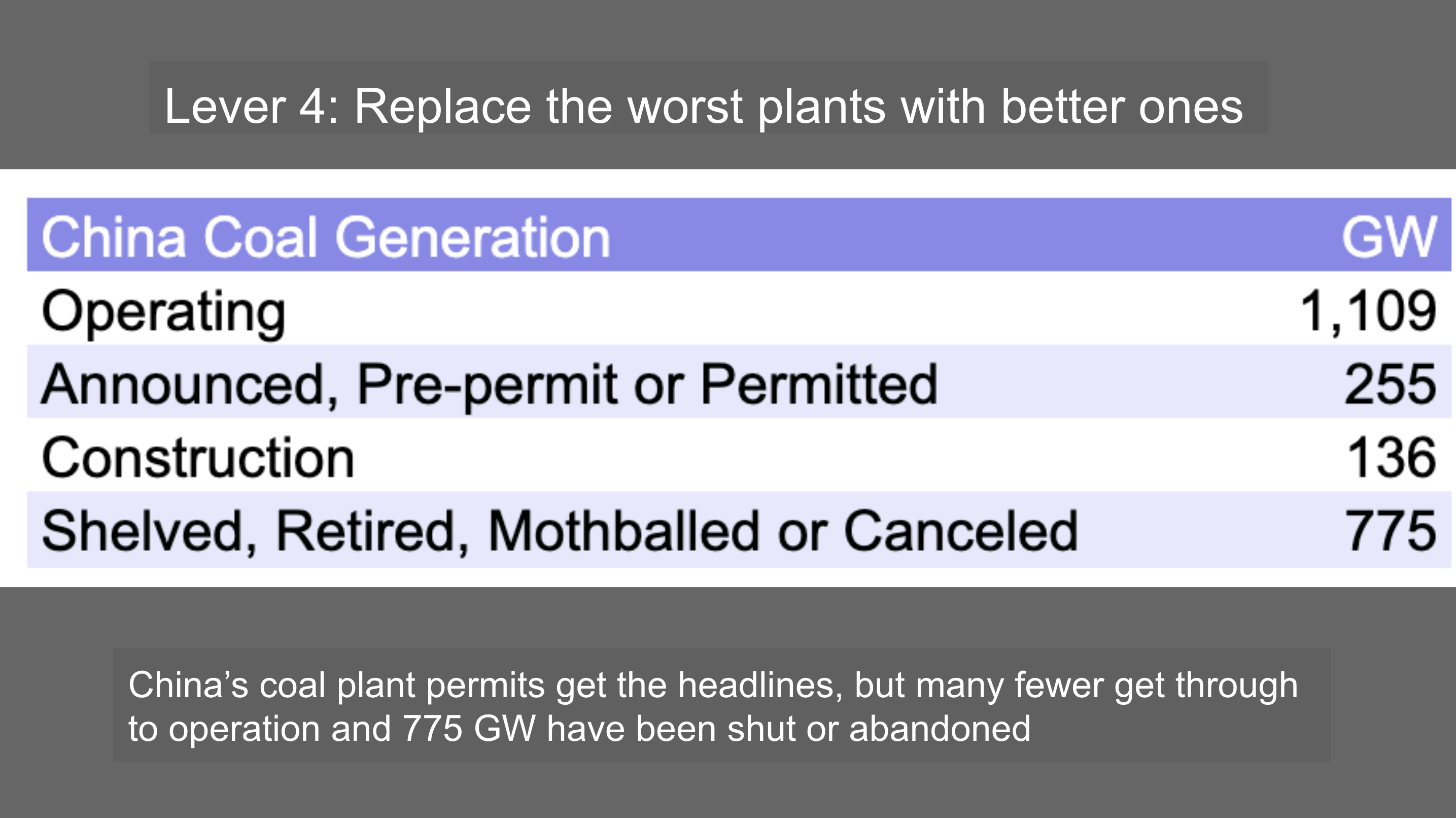
Lever four, replace the worst plants. Every time you shut down an old subcritical plant and replace it with a new supercritical plant or you shut down a lignite burning plant and replace it with a bitumen burning plant, you are reducing the impacts of coal generation.
While China gets a lot of bad press for the number of coal plants it’s building, what doesn’t get recognized is how many they’ve shut down. As we look at this, when I did this assessment last year, using the Global Energy Monitor data for China, they had 1100 operating gigawatts of capacity of coal plants. But they’d shelved, retired, mothballed or canceled 775 gigawatts of capacity. Now retired and mothballed just means they actually shut the plant down entirely. An operating plant, shut down entirely. Or they’ve decided that the announced pre permit or permitted plant was not going to go forward, for construction or permitting. They just canceled it. They said, we don’t need this, we’re not going to do this. So a bunch of the permitted plants ended up here. A bunch of operating plants ended up here. They made that choice.
What China is doing very intelligently is making sure that what coal it burns is burning in supercritical plants, which have about 60% of the carbon dioxide emissions per megawatt-hour. And it’s burning bitumen wherever possible instead of lignite, so that they get the benefits of that. They’re also washing their coal much more carefully. And the next piece. Part of the implications of coal mercury in the environment comes from most additional mercury in the environment, which causes brain damage and organ failures and insanity in many people. Most of that comes from burning coal. Sulfur in coal is what was contributing to acid rain. And so they’re consciously building much better coal where they build it, and they’re intelligently shutting down the worst plants. This is something for India to think about as we move forward. I have a merit order for Gujarat plants I’ll share at the end of this.
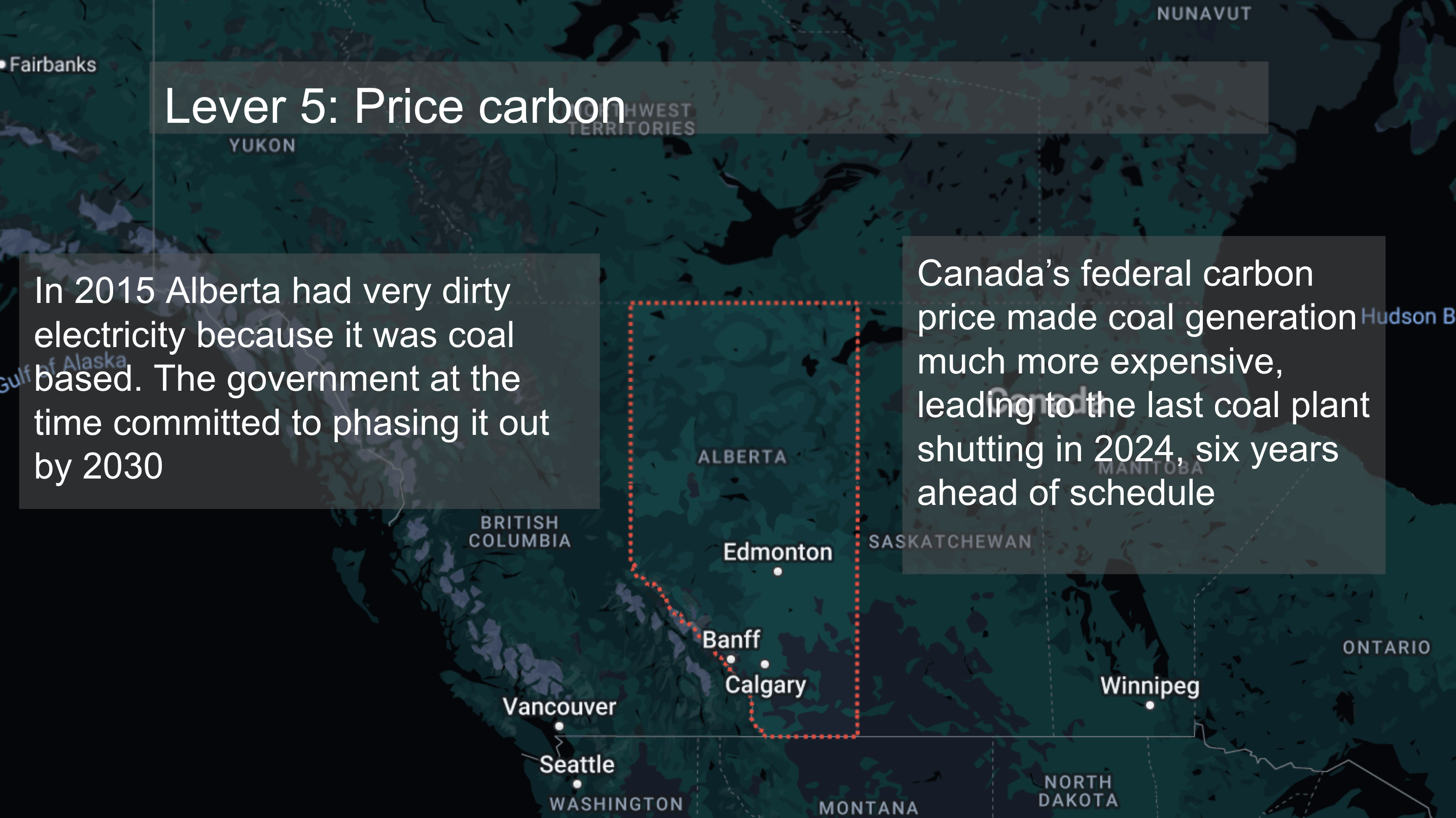
The next lever is pricing carbon. Alberta you might know, because that’s where Canada’s oil sands are. The oil sands are the highest emissions sector in Canada. The emissions from the oil sands in Alberta and the oil and gas industry in Saskatchewan have gone up quite a bit. So everything else that Canada has done, including Ontario shutting down coal over the past 20 years, have been swamped by the increases in Alberta and Saskatchewan. When I talked about the United States being virtuous for shutting down coal and then not being virtuous because they just replaced it with high emissions natural gas, well, Canada did a pretty good job in other parts of the country. And we failed miserably in terms of Alberta and Saskatchewan for similar reasons to the challenges that India faces.
The oil and gas industry is 5-6% of the Canadian economy. It’s difficult for politicians of any stripe to say, we’re going to get rid of 5% of our gross domestic product. It’s going to happen whether we like it or not. But Canada is making some of those same choices. When I talk about Ontario being virtuous and Alberta, we are not virtuous either. Our emissions have not come down. Now, in Alberta, they actually elected a sensible, centrist government at one point. In 2015, they had very dirty electricity. It was 800 or 900 grams of CO2 e per kilowatt hour. So almost a ton per megawatt-hour. That’s up in the level of, you know, above the level of supercritical coal.
That’s how bad it was. And a lot of their generation was from coal. A lot of it was from combined cycle, combined heat and power plants that were used for oil extraction on one side and electricity for the grid on the other side. And the government at the time said, well, we have to get rid of coal, at least. And so they made a commitment to phase it out by 2030. As I said at the time, that’s eleven out of ten for Alberta, because it was an amazingly progressive policy, and seven out of eleven for the climate, because I thought they could do it in ten years. I thought they could do it by 2025.
But also in 2015, the federal government that enacted the federal carbon price came in, and it applies to coal generation or other mechanisms that had to be put in place in provinces to equate to that. They had to be very careful about how they did that. They added costs to coal. I worked it out. By 2030, with Canada’s increases in our carbon price, the carbon price, if applied to the coal, would be four times the cost of the coal itself, coal being very cheap. So $40 a ton of coal, it’d be $120 per ton of coal burned just from the carbon price. That was a very significant impetus. Now, as we move forward, those coal plants in Alberta just said, well, we can’t make money this way.
Of course, Alberta was putting in wind and solar, until recently, that was a very sensible activity they were doing in Alberta, where they’ve got big, flat plains, and it’s pretty easy to string out transmission lines around a big, flat, underpopulated plain. From an India perspective, just think of Alberta as having a population of one of your tiniest cities. There are, I think, 4 million people in the entire massive province. As we move forward, the coal plant said well we can’t make any money, we can’t afford to operate. And so they did some work and they made some adjustments and they made some agreements and the coal owners got bought out effectively and the last coal plant shut this month. Alberta is now coal-free. Its emissions have halved. Now carbon dioxide emissions from electrical generation are half of what they were only nine years ago.
So that’s another way to do it. The carbon price started impacting profits and that created the competitive advantage. That means more people invest in wind, solar, storage, and transmission instead of coal. You’re pricing the negative externality. As I talked about in my previous lecture on Pigouvian carbon pricing approaches, it makes the economics change in a predictable way so that people can then make strategic decisions about how to achieve what they need.
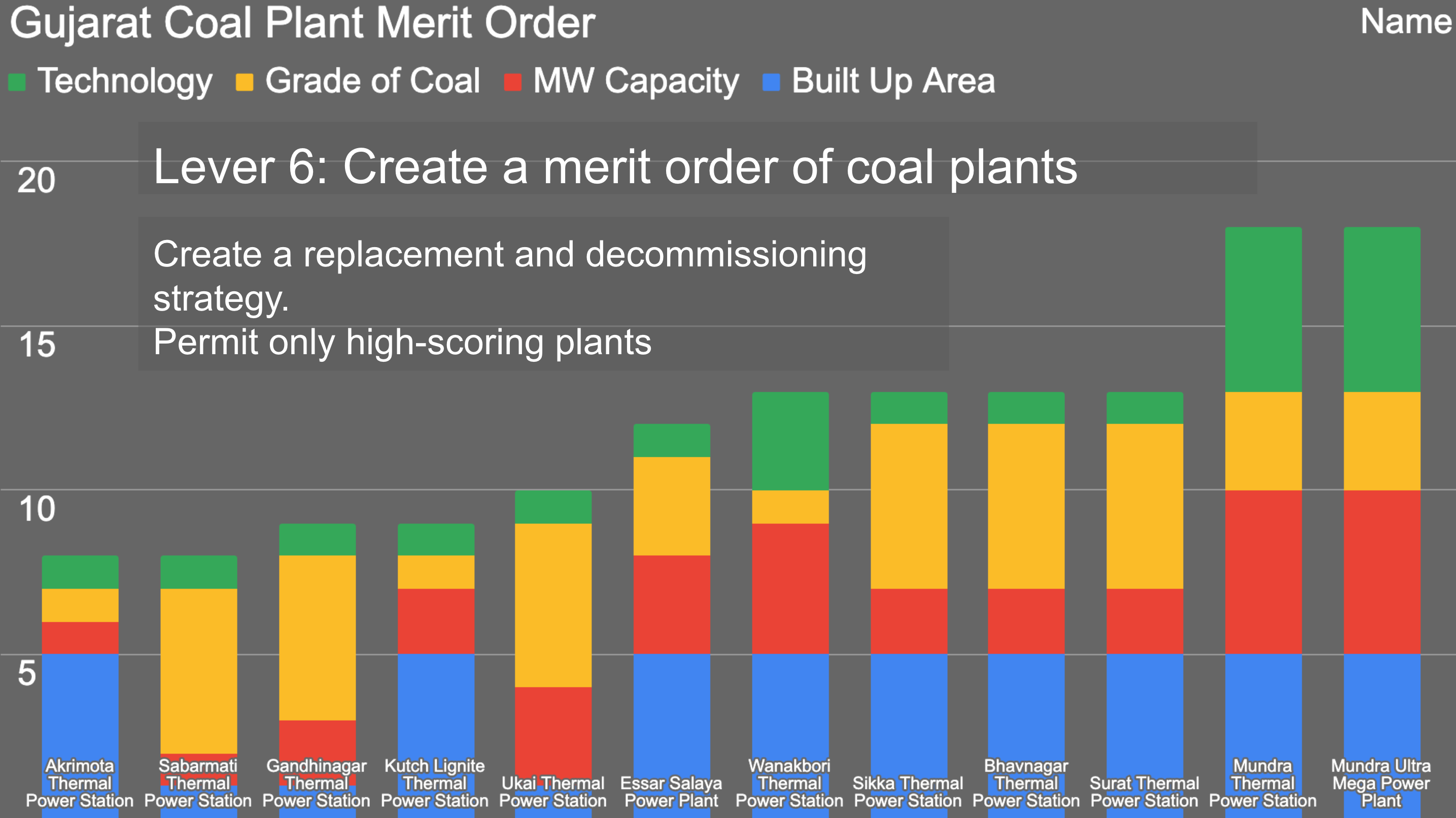
And so we get to Gujarat. I spent some time getting what I believe is the full list of coal facility coal generation plants in Gujarat. Once again if I missed one or have some inaccurate data from the public data I had available to me, my apologies. I created an initial course merit order for Gujarat’s coal plants.
What I said is what technology are they using? Is it supercritical or subcritical? Supercritical scores high. Subcritical scores low. So I just did a one to five rating simple unweighted criteria scheme and the grade of coal. Is it running lignite coal? That’s a bad score. Is it running imported bituminous coal because of the emissions that carry along the supply chain that’s higher emissions as well. That was kind of a medium score. Bituminous coal was ranked high because bituminous coal is the most efficient and the lowest CO2 per ton of coal burned. It’s not great, it’s far from great but it’s better than the alternatives.
Then megawatts of capacity. Big plants that are generating a lot of energy are a lot harder to replace than small plants. So small plants and you’ve got some plants that are in the 200-230 megawatt range. You have some plants that are some facilities that are in the four gigawatt range. So once again just a merit order of scale of plant indicating that size. Now the last one is a built up area. If the plants are in a built up area and three of the plants, per my public data are, well then they’re creating a lot more negative health impacts.
This is a coarse measure. What we can see is these plants over here tend to be small. They tend to be more in built-up areas. One, two, and three of them in built up areas.
Those plants that don’t meet this criteria should be replaced, if possible, with supercritical plants burning bitumen, bituminous coal. If they’re in a built-up area, just shut down and a new plant built outside of the built-up area. This is a more nuanced way of looking at it. Coal is a necessary evil. But we can diminish the amount of negative impacts of it with supercritical coal, with high grade coal, with better washed coal, and by keeping it away from people as much as possible.
This does require building some transmission and building some storage. But you’re building transmission and storage anyway. I will say that a lot of coal facilities now are being repurposed with storage and lots of solar. As much as they can pack into the space. And that’s something seriously to consider for the places you shut down.
But getting rid of those coal plants significantly reduces the negative externalities in Gujarat. And because the generation is relatively low, it’s relatively easy to replace these ones over here that aren’t. The four gigawatt plants aren’t in built-up areas as far as I know. And they’re running supercritical coal. They’re the most modern facilities with the lowest emissions. Makes sense for those to persist the longest.
One of the recommendations of this material is to create the merit order based upon all of these factors. Only permit new plants that score high, supercritical, bituminous away from people, big capacities, get the most efficiency you can out of them, and then expect them to have diminishing capacity factors.
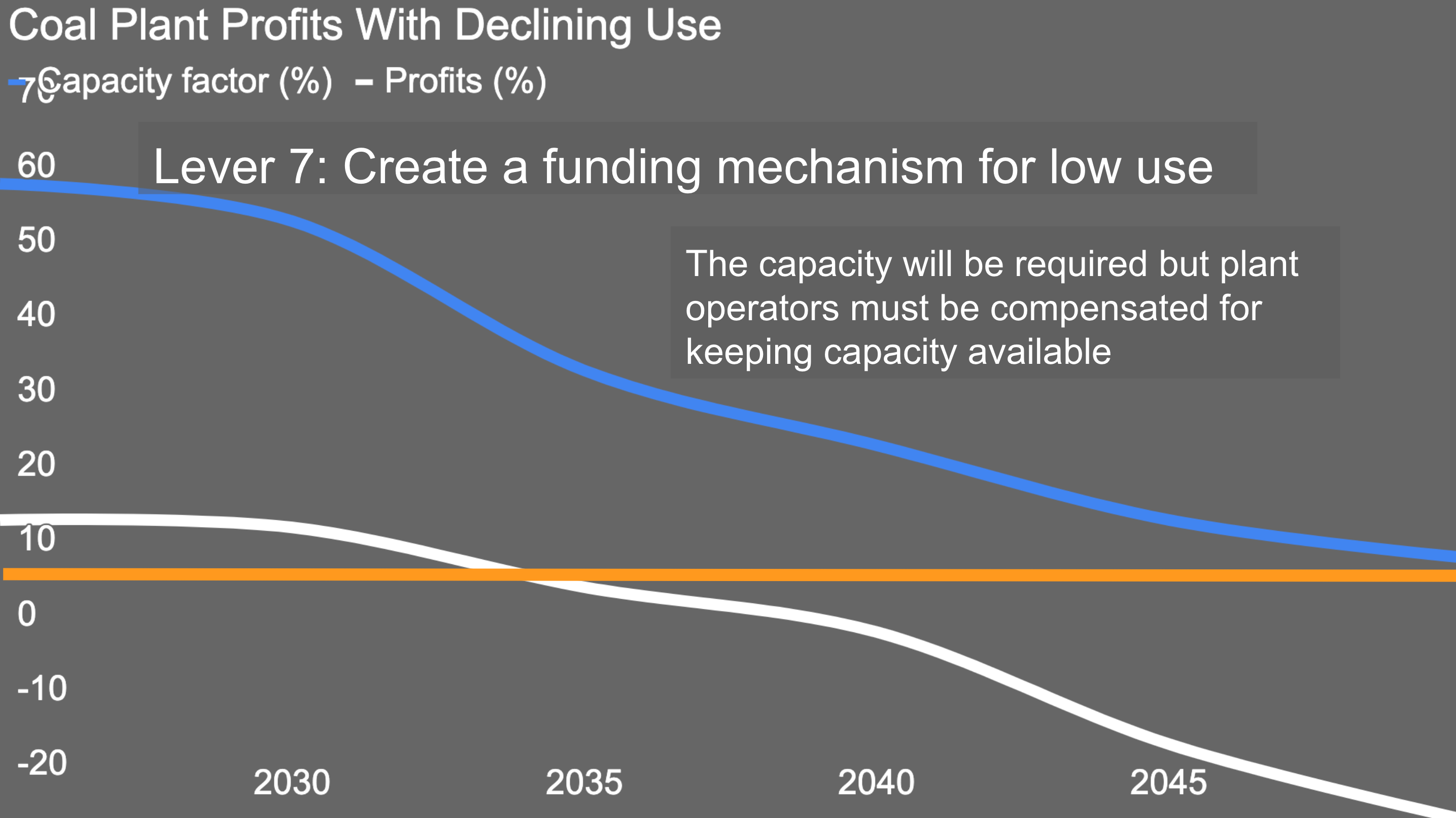
So this is just kind of a perspective. This is a thought experiment. At what point does a coal plant stop making money? That’s part of what happened with the coal plants in Alberta, but it also happened in Europe, in Denmark, they were generating with a lot of coal. Now, Denmark, as you may know, is famous because it’s the home of Vestas, one of the world’s most innovative leading wind turbine manufacturing companies. And it has been since the eighties. It’s just amazing history there. And they’re frequently at 150% to 160% of demand met from wind on any given day, and they’re well into the high percentages. 20 years ago, they already realized their coal plants were problematic because they needed the capacity for flexibility, but they needed them at low capacity factors, the private company, under normal market rules, wouldn’t agree to actually operate them. They just say, well, we can’t make money, so we’re going to exit.
So as the capacity factors decline, at some point profits get below a level where private industry is remotely interested. I’ve notionally pegged it at 5% or 6% profits, just notionally as a thought exercise. And below that they’ll just shut the plants down. But you need the plants through 2050 to have some capacity in reserve, just because as you build up wind, solar and storage, eventually you’ll just be using fossil fuel generation less and less. But you still need it around. You don’t want people in New Delhi to lose air conditioning during the summertime. That’s just a recipe for disaster. So you have to keep grid reliability high, you have to keep electricity there.
So you need to create a funding mechanism. Now, Denmark, they nationalized their coal plants and they treated them as a governmental expense for capacity. That’s what they did. In the UK, they explicitly have a capacity market where people bid to provide capacity, and pumped hydro, for example, is under that model. So pumped hydro has actually got capacity markets in the UK, and coal plants can have capacity markets as well. Those are annualized capacity. Just the ability to turn on and deliver electricity when it’s required has value on grids. I don’t know what India is doing in this regard. I didn’t have time to figure out if India is in this space. But you’ve got to do something to enable those coal plants as they diminish and diminish in electrical generation, health impacts and carbon emissions.
You’ve got to still find a way for them to bridge this fiscal gap and enable them to make enough money to stay open.

The first question is will electrification of the mining industry be a solution to shutting down coal plants? Well, I would say increasing demand in the mining industry is not a way to reduce the demand for electricity that coal plants provide. It is a way to make mining much more virtuous in and of itself. But mining is a heavy power organization now. All sorts of people around the world are dealing with this. If we take mining as an example, Australia, there was a big mine there eight or nine years ago. It was a big copper mine. They had a requirement to significantly decarbonize the mine, electrify as much as possible. And what they did is they built a 40-megawatt solar farm near the mine. Mines tend not to be in the middle of highly populated areas for a variety of good reasons. And so they just built a lot of solar near the mine, and they significantly reduced their emissions as they moved forward.
Certainly mining is a place where electrification is clearly the winning one, where we have, as we look around the world, BHP, Rio Tinto, Vale, and Fortescue have all now asserted, and these are major giants. They’ve all asserted that as they’ve looked at decarbonizing mines, electrifying the mines is the answer. We’re starting to see more and more of the massive trucks being electrified.
There’s even one mine where they have this incredibly successful solution. The mine is at the top of the hill. They load the big trucks up and run them downhill, regeneratively braking to the valley to put them on rail cars. Then they drive the truck up with electricity they generated with regenerative braking on the way down. So they actually consume no electricity from anywhere in that model. The truck generates its own electricity because it’s braking because of the massive amounts of ore, and its big hopper in the back. So I don’t think electrification in the mining industry is a solution. They need energy. If they electrify, they need more electricity, and India needs to provide that electricity. But it is the right thing to do.
The next question is about the efficiency factors of coal plants versus non fossil distributed generation. This is an interesting one. There is a simplistic way of looking at efficiency and capacity factors of different technologies. What is possible with them? And so in the fossil fuel world, efficiency really matters because you’re consuming a fuel that has an operational cost. Even if it’s only $40 per ton for coal, you’re still paying to use it.
You want to get as much out of it as possible. But coal and gas are thermal generation. In thermal generation, you’re boiling water to make steam to turn turbines. That cycle has significant limits in terms of efficiency, just thermodynamics. You’re creating heat, which is not creating work. So a coal plant might have 38 or 40% efficiency at turning coal into electricity. A gas turbine, which is specifically used for speeding up fast, very high speed, ramp-up peakers. That might have an efficiency of only 25% or 20%, but it’s okay because you’re using it so rarely. A combined cycle gas plant, what they do is they actually run a turbine with power from the generation, but then they use the waste heat to also power it. So they actually get up to 50, 55% efficiency factors.
People who are burning fossil fuels want to do it as efficiently as possible, so they make the most money. It’s just something that’s been going on for years, and the industry is doing great stuff. But as we look at that on the other side, people claim that solar isn’t good because it only has a 20 or 25% capacity factor, or it’s fairly low efficiency at turning sunlight into energy, but we don’t care because no one’s paying for the fuel. Same with wind. Wind has a maximum efficiency of 59.3% of the wind’s energy that flows through the blades can be theoretically captured by a sufficiently engineered wind turbine. And so we’re approaching that. We’re at 90% to 95% of Betz’ limit in wind energy. That sounds bad, but we don’t care because the wind and the sun are free.
There is no operational cost for fuel. Becomes important to think about these things as the levelized cost of electricity is the measure, not the efficiency. As we price carbon, the levelized cost of electricity from fossil fuels, no matter how efficiently they’re burned, goes up. But the levelized cost of electricity from wind and solar stays the same because there are no emissions during operation. The efficiency is a bit of a red herring. What you have to do is abstract it up to the point where you’re looking at the economic discussion. Lazard has been doing its levelized cost of electricity assessments for possibly a decade now. Most recently, in the past few years, they’ve tended to focus on the United States, which has diminished their value substantially, from my perspective.
But in the United States, solar or wind firmed with battery storage are still cheaper than gas or coal, even in the United States, where they don’t have a price on carbon emissions and coal or gas generation. As soon as we say firm electricity from renewables is cheaper than gas or coal generation, there is no economic argument left. The United States is just, regardless of any policies from any level of government, the United States is just going to build a lot more renewables. And this shows, by the way, I looked at some trajectories for the penetration of wind and solar from the Obama Biden administration, the Trump administration, and then the Biden Harris administration. And the curve was exactly the same for twelve or 13 years. Nothing the government did changed it.
The Trump administration’s quite famous hatred of wind energy did nothing to the slope of deployment of renewables. Because they’re cheaper, because they’ve been proven to be reliable on grids, they have zero correlation with reliability. They’re not expensive, and so everybody’s just buying them, and they will, so they’ve won. And so we’re just going to keep doing it. But giving tailwinds to the renewables and headwinds to coal and gas is the right choice, and they find their optimal balancing point.
Next question. When coal plants are shutting down in developing countries, are they stopping the extra coal extraction? Also, the coal can be exported. Is there any international mechanism to stop that? It’s a great question.
So recently I looked at the United States, which has dropped its coal generation, and you would expect the amount of coal that it mines would diminish in alignment with that. Well, there was a dip, but now coal mining is back up to where it was in 2000. [I just relooked at this, and while coal exports are up recently, they are not up as much as generation demand is down.] And the reason for that is exactly your point. The United States is a coal exporting country, just as it has become the world’s biggest oil exporting country and the world’s biggest natural gas exporting country. Believe it or not, the United States is now a petrostate. It is its own Middle east, which is creating many of the problems we’re seeing in the country.
I know India has been having some of these discussions as well. Adani, I believe it was attempting to mine Australian coal and build a railroad to get it to the shores, and I believe, blast a hole through the Great Barrier Reef, which was quite an odd choice, and then ship that high grade bituminous coal to India to burn in India’s coal plants. This was being touted as an environmental win, and it’s really very difficult to call that an environmental win. But yes, coal exports are happening. I’m just going to say, once again, Canada is not virtuous on this. We’ve been destroying mountains in western Canada and shipping the coal to Japan and China for decades. It’s one of the things we do that we have nothing to be proud about. So, yeah, coal is just a commodity. The mechanism to stop that is to price carbon in all countries, or have the carbon price be applied.
As I said, Europe has the world’s largest trading block, with the highest flows across its borders and so many exports to Europe from a lot of countries like China. That means that if you’re burning coal to make your products, they’re high carbon emissions and they’ll be priced accordingly. Entering Europe, any country which says, well, we’re going to just buy all this cheap coal and that’s what we’re going to use to power our economy, is setting themselves up to be priced out of the global trade markets because their emissions will be priced. That’s an emerging thing. As I said in a discussion on carbon pricing, North America almost had a carbon border adjustment mechanism. China has a carbon price. Parts of Indonesia have carbon prices. California has a carbon price, carbon border adjustment mechanisms and pricing that are going to be there.
Next question. How do we compare the land requirement of coal plants with reference to other options? I would say this is a significant red herring if we look at the land requirements globally. Mark Z. Jacobson has done this in his work on this. What he’s found is that we use so much land for coal, oil and natural gas extraction, processing, refining, distribution, generation and use that it’s actually greater than the total land required for renewables in our future. In part because of the primary energy fallacy, which I discussed earlier in the series as well, where if we look at a modern economy, we need less than half of the primary energy coming in to deliver all the energy, as long as we’re going from wind, solar and water to electric energy services.
The land requirements of coal plants, they’re actually quite big. They take up quite an amount of land themselves, but you can’t put enough solar on them or wind on them to generate as much electricity as a coal plant does. But that’s not the point. I always like to use an image from the Netherlands, which has a lot of wind energy, with massive, beautiful fields of tulips and different beautiful colors and blooming flowers, with wind turbines all over the place. In an operational field-based agricultural system, wind energy takes up maybe 1% of the land, and you can make a choice about putting it on the least productive portions of the land. That includes the wind turbine bases, the access roads, the additional equipment for power generation. It’s 1%.
On ridgeline wind, you’re taking up 2% of land, but typically of land where nothing’s happening except trees are growing. So you may be taking up 2% of the land, but you still have other stuff happening, including just nature between them. And solar is different because, yeah, if you’ve got a four gigawatt solar farm that’s ground-mounted, that’s a lot of land. Typically you only do that in Mongolia or someplace where there aren’t a lot of people. But even in China, they’ve got massive amounts of solar on rooftops because we have all these rooftops, we’ve got flat roofs everywhere. And so just by putting solar on every rooftop that we can actually generate a tremendous amount of electricity with zero additional land requirements.
I typically see this argument with nuclear plants in the west, but yeah, the land use, it’s an economic factor. I had this discussion a decade ago with a MacArthur Genius Grant fellow, John Dabiri, where he was trying to argue that land use of wind energy was problematic. I said, no, it’s just costed in. We lease a little bit of land from a farmer, they get a revenue stream of $6000 to $18,000 US per year at that time in the United States, an additional drought-proof revenue stream. And that’s factored into the cost of electricity. And so land use is just something that goes into the levelized cost of electricity. And that’s the way to think about it.
I will say that India is not unique in this, but it is perhaps more challenged than many because you have over 1.4 billion people now in an area a third the size of Europe or China or the United States, geographies I tend to compare you to. And so you’ve got a larger amount of people in a smaller geographical area. But still, wind energy doesn’t take up much space. We now have offshore wind and floating offshore wind. You’ve got a lot of agricultural land where you can just put up wind turbines, and a lot of rooftops where you can put up solar. And I think that’s it for questions. Reji, do you want to close it out or do you want to ask any other questions, make any other comments?
RP: No, as I said, I am not in a good environment with a lot of background noise, so wouldn’t like to. But this is a very important topic, which we would like to have a higher level discussion with the decision-makers in India about a roadmap for closing down coal plants. This is a very important topic we should take up. And you rightly talked about the land requirements. We are also of late promoting agrivoltaics, which is very successfully done in parts of China. So the farmer gets to cultivate the land as well as get an income from the solar plant developers. So just by raising the height of the structure, many things can be planted below the solar panels because every crop doesn’t need direct sunlight.
And we, India, the largest solar farms we have built are in Dajistan and Gujarat, where a huge area is actually a desert, so that is being efficiently used. And we have one of the world’s largest floating solar plants, which is in Madhya Pradesh. It’s about 960 megawatts.
Have a tip for CleanTechnica? Want to advertise? Want to suggest a guest for our CleanTech Talk podcast? Contact us here.
Latest CleanTechnica.TV Videos
CleanTechnica uses affiliate links. See our policy here.
CleanTechnica’s Comment Policy





